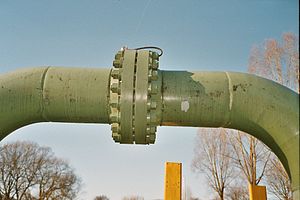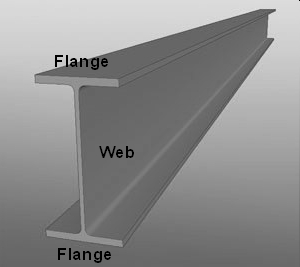Flanges in construction

|

|
[edit] Introduction
A flange is a projecting ridge, rim, collar or ring on an object such as a column, beam, pipe and so on that provides additional strength or stiffness or additional surface area for the attachment of, or to, another object. For example, flanges may be used to strengthen beams, or to connect or terminate pipes.
Where another object is to be attached, a flange may include bolt holes.
[edit] Pipework flange
Flanges are used in pipework systems for connecting and attaching pipes, valves, pumps, and so on. As an external or internal ridge, or rim, flanges are usually designed to interface sections of pipe and enable easy assembly and disassembly.
Typically, a flange is a forged or thrown ring of stainless steel that is welded or screwed to another component in the system. To create a flanged joint in a pipe system, two connecting pieces with flanges at the end are bolted together, with a seal provided by a gasket between them.
The dimensions of flanges are determined by the size of the pipe as well as the pressure class required for the application. The pressure class ratings that flanges are designed to are typically: 150 lb, 300 lb, 400 lb, 600 lb, 900 lb, 1,500 lb, and 2,500 lb. There are many different flange standards worldwide, with organisations such as ASME, MSS, and API publishing standards.
There are numerous types of flanges, including:
- Blind: This is a plate for covering or closing the end of a pipe, mainly used as part of high pressure weight applications.
- Expander: The non-flanged end is larger than the flanged end. This is used to change the size of a pipe run.
- Groove/tongue: This combination of a raised ring (tongue) and depression (groove) align together precisely.
- High hub blind: This is a simple round plate without a centre hold.
- Lapped joint: Used on applications with lap joint stub ends or lapped pipes, typically where cleaning or inspection is regularly required.
- Orifice: Typically used with orifice metering systems for gauging liquid and gas flow rates.
- Plate: Similar to a gasket, typically used in applications made from casting.
- Reducing: Used in applications with different pipe diameters.
- Ring type joint: A metal ring with a hexagonal groove compressed to a flange to form a seal.
- Slip-on: This flange slips over the pipe and is welded at the top and base side.
- Socket weld: Pipes are inserted into the sockets of flanges and welded for smooth flow. This tends to be used for smaller pipes.
- Spectacle: Comprises two discs attached with the help of a small metal (usually stainless steel, alloy steel, etc.) section.
- Square: A square-shaped flange.
- Threaded: This flange is fixed to a pipe using threads rather than welding, and so are more commonly used for low pressure applications.
- Weld neck: This helps transfer stress from flange to pipe, and is suitable for high pressure applications.
- Weldo/Nipo: A combination of weld neck flange and a nipolet (a one-piece fitting for valve take-offs, drains and vents).
[edit] Related articles on Designing Buildings
Featured articles and news
The 5 elements of seiri, seiton, seiso, seiketsu and shitsuke.
Shading for housing, a design guide
A look back at embedding a new culture of shading.
The Architectural Technology Awards
The AT Awards 2025 are open for entries!
ECA Blueprint for Electrification
The 'mosaic of interconnected challenges' and how to deliver the UK’s Transition to Clean Power.
Grenfell Tower Principal Contractor Award notice
Tower repair and maintenance contractor announced as demolition contractor.
Passivhaus social homes benefit from heat pump service
Sixteen new homes designed and built to achieve Passivhaus constructed in Dumfries & Galloway.
CABE Publishes Results of 2025 Building Control Survey
Concern over lack of understanding of how roles have changed since the introduction of the BSA 2022.
British Architectural Sculpture 1851-1951
A rich heritage of decorative and figurative sculpture. Book review.
A programme to tackle the lack of diversity.
Independent Building Control review panel
Five members of the newly established, Grenfell Tower Inquiry recommended, panel appointed.
Welsh Recharging Electrical Skills Charter progresses
ECA progressing on the ‘asks’ of the Recharging Electrical Skills Charter at the Senedd in Wales.
A brief history from 1890s to 2020s.
CIOB and CORBON combine forces
To elevate professional standards in Nigeria’s construction industry.
Amendment to the GB Energy Bill welcomed by ECA
Move prevents nationally-owned energy company from investing in solar panels produced by modern slavery.
Gregor Harvie argues that AI is state-sanctioned theft of IP.
Experimental AI housing target help for councils
Experimental AI could help councils meet housing targets by digitising records.
BSRIA Occupant Wellbeing survey BOW
Occupant satisfaction and wellbeing tool inc. physical environment, indoor facilities, functionality and accessibility.























